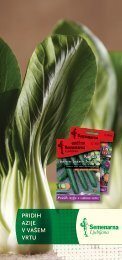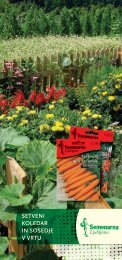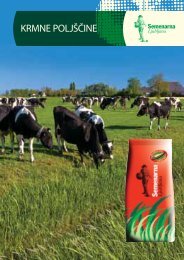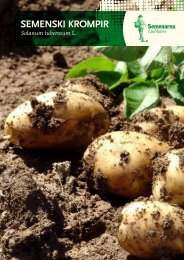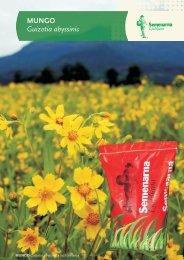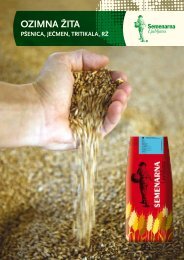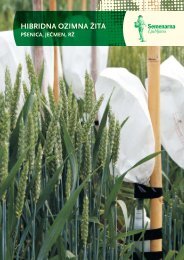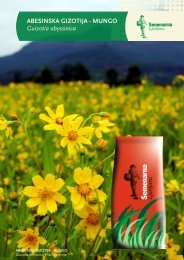katalog_ENG_20080221.indd 1 2/26/08 3:26:36 PM - Semenarna ...
katalog_ENG_20080221.indd 1 2/26/08 3:26:36 PM - Semenarna ...
katalog_ENG_20080221.indd 1 2/26/08 3:26:36 PM - Semenarna ...
You also want an ePaper? Increase the reach of your titles
YUMPU automatically turns print PDFs into web optimized ePapers that Google loves.
64 Valentin Valentin in the garden<br />
Valentin peat pots<br />
Valentin peat pots are used for sowing and cultivating seedlings<br />
and nursery cuttings of VEGETABLES and FLOWERS. Peat pots are<br />
decomposable and have high capacity to retain water. The roots<br />
of young plants are developing faster and so the plants are more<br />
resistant to potential attacks of diseases and pests.<br />
Valentin peat tablets<br />
Valentin peat tablets are used for sowing and cultivation of<br />
seedlings and nursery cuttings of VEGETABLES and FLOWERS.<br />
USAGE. Before the use the tablets should not be soaked, but<br />
moistened on a platter or some other flat surface. The moistening<br />
is finished when the tablet grows to the height of approximately<br />
3 cm. In the tablet, prepared in this way, a nursery cutting or<br />
seed is inserted. Because the tablet contains a fertiliser with<br />
microelements, the seedling needs no more fertilisation until<br />
the transplantation. The tablets should be placed in a bright and<br />
warm place (approx. 22°C), not on direct sun, and should be<br />
watered regularly. When there are small roots coming through<br />
the tablet, the seedlings should be transplanted. The seedlings<br />
should be transplanted together with the tablet because in this<br />
way, the root system has no injuries.<br />
Valentin Envirofleece (winter, summer)<br />
The Envirofleece protects the plants from frosts and temperature<br />
changes, storms, strong rain, and hail. It prevents the soil from<br />
drying out too fast. It also protects the covered plants against the<br />
attacks of pests. The equated microclimate under the Envirofleece<br />
enables an earlier sowing, stronger growth, and earlier<br />
development of plants in spring. In winter, it enables a longer<br />
growing period and overwintering. The plants are well protected.<br />
The harvest is better!<br />
The garden year<br />
JANUARY<br />
A sowing plan should be made in which, besides vegetables, also herbs and flowers are<br />
considered. The lawn should be fertilised over the snow blanket because with the snow<br />
melting, nutritional substances will also trickle into the soil. Pot plants in the house should<br />
be watered and fertilised modestly because they are resting in winter, as well.<br />
FEBRUARY<br />
On a warm place, early cabbage, celery, cauliflower, early lettuce, tomato, pepper, aubergine<br />
etc. can be sown. Towards the end of the month, we can start with the pruning of fruit<br />
trees. All pruned branches which are as thick as a pencil and bigger, should be protected<br />
with graft resin which is also used for covering and protecting the wounds and clefts on<br />
the tree bark. Bulbous begonias are those among the flower bulbs which should be “germinated”.<br />
MARCH<br />
In the hot bed, early lettuce, tomato, red pepper, celery, cauliflower, cabbage, kale etc.<br />
should be sown, and outdoor, peas, parsley, carrots, lettuce, kohlrabi etc. Sowings in the<br />
open air should be covered with a garden tissue. The place for compost should be prepared<br />
in the half-shadow and the compost enhancer should be prepared, as well. Fruit<br />
trees should be fertilised under the treetop where the roots which are getting nutritional<br />
substances from the soil are situated. Furthermore, rhododendrons and coniferous trees<br />
should be fertilised. We should rake up the garden lawn and fertilise it. Flower bulbs for<br />
the summer and autumn flowering, as well as roses, should be planted. Pot plants should<br />
be transplanted.<br />
APRIL<br />
Beetroot, lettuce, radish, carrot, parsley, and annual flowers should be sown. Onion and<br />
potato should be planted. Crops should be protected from the cold with Valentin Envirofleece.<br />
The garden lawn should be ventilated, raked up, and fertilised. The soil should<br />
be prepared for a new lawn which is going to be sown in May. Rhododendrons, coniferous<br />
trees, decorative bulbous plants, and other decorative plants should be planted. Pot<br />
plants should be transplanted and balcony flowers planted.<br />
MAY<br />
Beans should be planted into a warm soil on a sunny area. Broccoli, chinese cabbage, tomato,<br />
pepper, cucumbers, pumpkins, marrows, cabbage, celery etc. should be transplanted<br />
into the open air. Balcony plants should be planted on the balconies, window shelves,<br />
terraces, and flower beds. Make sure that the garden lawn is doing well; it should be raked<br />
up, ventilated, the weeds and moss destroyed, and fertilised. For sowing the lawn suitable<br />
grass mixture should be used!<br />
JUNE<br />
On the garden beds where we harvested the first crops, the plants for green fertilisation<br />
can be sown. Among the vegetables, broccoli, kale, turnip, carrot, parsley, radish, summer<br />
white radish, beetroot, chicory, and kidney bean should be planted and transplanted, and<br />
near the end of the month, also endive. Biennial flowers should be sown. The lawn should<br />
be regularly mown, fertilised, and watered in dry weather. Trees, decorative plants, balcony<br />
flowers, and pot plants should be further fertilised.<br />
JULY and AUGUST<br />
Winter radish, turnip, kohlrabi, radish, spinach, chicory, and chinese cabbage should be<br />
sown, and in August, also winter lettuce, chard, and corn salad. Strawberries should be<br />
planted and vegetables, trees, lawn, and pot plants further fertilised. Roses should be<br />
fertilised for the last time so that the wood is going to be well ripened until the winter. We<br />
should regularly remove the dying-off flowers from the balcony flowers, as well as water<br />
and fertilise them.<br />
SEPTEMBER<br />
Corn salad, winter lettuce, spinach, chard, and plants for green fertilisation should be<br />
sown. In the beginning of the month, cauliflower and winter endive which we are going to<br />
gather in October should be fertilised once again. Decorative bulbous plants which are going<br />
to flower in spring (daffodils, crocuses, muscaris etc.), as well as bushes and perennials,<br />
should be planted. It is once again time for the sowing of decorative lawn, because<br />
the time of the summer drought has usually already passed by then. The garden should be<br />
cleaned and the leftovers placed on the compost.<br />
OCTOBER<br />
Onion sets and autumn garlic should be planted. Vegetables and perennial herbs should<br />
be protected from the cold with a Valentin Winter Envirofleece. Flower bulbs, which are going<br />
to flower in spring (tulips, daffodils, crocuses, etc.), as well as bushes and perennials<br />
should be planted. We should plant the graves and tidy them, as well as beautify their surroundings<br />
with decorative bark. Th pot plants should be fertilised.<br />
NOVEMBER<br />
Fruit and ornamental trees and roses should be planted. The soil around the newly planted<br />
fruit trees should be covered with mulch. The vegetable garden beds should be protected<br />
with Valentin Winter Envirofleece and we should start cultivate sprouts (BioValentin seeds<br />
for sprouting) at home. It is still time for planting the tulips, and in warmer areas, also for<br />
planting other bulbous plants; roses and decorative trees are planted, as well as Amaryllis<br />
into the pots. Pot plants should be fertilised and watered less regularly.<br />
DECEMBER<br />
Poinsettia and other pot plants should be regularly watered and fertilised, so that they will<br />
beautify our holiday. Amaryllis can still be planted. Sprouts are cultivated during the winter<br />
months to improve our health.<br />
<strong>katalog</strong>_<strong>ENG</strong>_<strong>20<strong>08</strong>0221.indd</strong> 64<br />
2/<strong>26</strong>/<strong>08</strong> 3:43:20 <strong>PM</strong>





